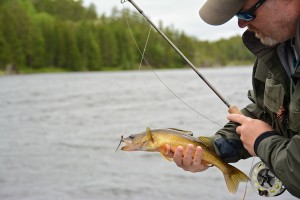 I did a little fly fishing for walleye this summer, including a week-long trip to Ontario for just that purpose; I can’t say they are my new go-to specie. In fact, I failed rather miserably in catching any good size walleye, my best being nothing greater than a 15 or 16-incher. I saw some eight to ten-pounders caught and released, but that was by the gear guys throwing minnows and leeches. So I’m not thrilled with news that walleye are in the lower Clark Fork River and Lake Pend Orielle, and that they are there to stay. This may not bode well for the Kamloops rainbows that Pend Orielle is famous for and it certainly doesn’t spell good things for the natives, meaning cutthroat and bull trout. Here’s the full skinny on this new walleye dilemma and the realization that those long-fanged mongers may be here to stay.
I did a little fly fishing for walleye this summer, including a week-long trip to Ontario for just that purpose; I can’t say they are my new go-to specie. In fact, I failed rather miserably in catching any good size walleye, my best being nothing greater than a 15 or 16-incher. I saw some eight to ten-pounders caught and released, but that was by the gear guys throwing minnows and leeches. So I’m not thrilled with news that walleye are in the lower Clark Fork River and Lake Pend Orielle, and that they are there to stay. This may not bode well for the Kamloops rainbows that Pend Orielle is famous for and it certainly doesn’t spell good things for the natives, meaning cutthroat and bull trout. Here’s the full skinny on this new walleye dilemma and the realization that those long-fanged mongers may be here to stay.
From The Columbia Basin Bulletin
A newcomer is establishing itself in northern Idaho. Walleye, a staple of the midwestern United States, have not historically been a part of the northern Idaho landscape. They have found their way into area waters fairly recently.
Lake Pend Oreille, well known for its kokanee, Kamloops rainbow trout, bull trout and cutthroat is now also home to a growing walleye population.
Walleye were illegally introduced into the Clark Fork River, upstream in Montana. They gradually worked their way downstream into Idaho and were detected in Lake Pend Oreille and the Pend Oreille River around 2004-2006.
Although occasionally caught by anglers, substantive catches of walleye weren’t really evident until 2010.
The Idaho Department of Fish and Game completed walleye surveys in 2011 and 2014 that showed walleye are expanding. Using gill nets, IDFG biologists sampled waters from the Clark Fork delta, across Lake Pend Oreille, and down the Pend Oreille River.
Catches show walleye abundance has nearly doubled in the three years between surveys.
Walleye in the Pend Oreille system are growing fast. Five- and six-pound fish are relatively common. Although walleye are increasing, they are still relatively low in abundance compared to well- established populations in the Morthwest such as Washington’s Lake Roosevelt, with over twice as many walleye per acre.
Walleye present a unique challenge for fishery managers. They are often revered by anglers for the quality of their meat and the challenging angling experience they provide. A walleye fishery has not been available in northern Idaho, and biologists recognize it is something a number of anglers desire. READ MORE AT CBB
